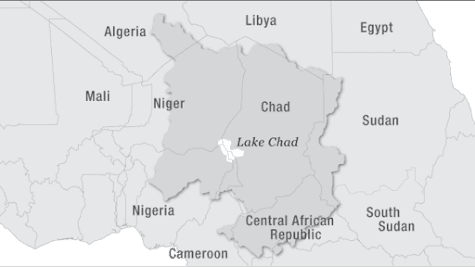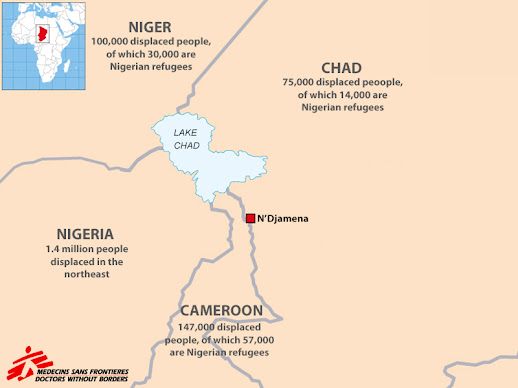The Prone-To-Conflict Context of the Shrinking of the Lake Chad Basin
Hello again! In this second post, I will try to go into a bit more depth on the Lake Chad basin and its vulnerability to conflicts on water.
The Lake Chad region (dark grey on the map) is located in the West-Central Africa. The Lake Chad basin (white on the map) is constituted of four riparian countries; Nigeria, Niger, Cameroon and Chad.
The transboundary basin has increasingly been the centre of attention of journalists, environmentalists, scholars and civil organisations as its freshwater’s quality and quantity has been deeply reduced (Okpara, et al., 2015). Indeed, since the 1960s, the Lake Chad basin has shrunk by over 90% of its original size from 25,000 km2 to 2,500 km2 today (Ruppel, Funteh, 2019/ Kusumawardani, 2017). It is considered as one of the most water-stressed regions in the world with critical socio-economic and political pressure (Okpara, et al., 2015/Ruppel, Funteh, 2019). Much of the 30 million people living in the lake region are strongly dependent of the lake resources as means of subsistence (Onuoha, 2008/Ruppel, Funteh, 2019).
The reasons behind the shrinking of the lake are numerous. The most widespread concern for the lake's depletion is global warming and the unfolding hydrological changes. It is illustrated by higher temperatures, shifting precipitation distribution resulting in an important evapotranspiration of approximately 2,200 mm/year and an unevenly-shared surface water (Ruppel, Funteh, 2019). These are combined with a strong demographic pressure. The population of the Lake Chad region is evaluated to be growing of 3% each year (Okpara, et al., 2015). Increasing population dynamics are evidenced by the overexploitation of water for food by unsustainable agriculture and fishing practices. Desperate coping mechanisms reinforce the prevailing socio-political tensions of poverty, unemployment and ethnic heterogeneity (Ruppel, Funteh, 2019). Furthermore, the unilateral use of the lake’s resources from the riparian states appears as an important driver of the Lake Chad’s shrinking. Major constructions in the region such as the Yaguou-Tekele dyke on the Chari-Logone River or Cameroon’s Maga dam are responsible for excessively diverting waterflow (Rupple, Funteh, 2019). Finally, the poor water governance, struggling with corruption, underdevelopment and regional instability due to terrorism lacks political authority to fully enforce regulations to protect the basin (Ruppel, Funteh, 2019). This is a concern at all scales, from the regional Lake Chad Basin Commission to the international African Charter on Human and Peoples' Rights.
The direct consequence of the shrinking of the Lake Chad basin is the worsening of two potential conflicts, first, an increased competition over water sovereignty and consumption, and second, the ever-growing migration and internal displacements in the region, recently counted at more than 1.6 million people (Ruppel, Funteh, 2019/ Kusumawardani, 2017). Therefore, the lake's shrinking is the cause of an acute humanitarian crisis of food, environmental and broader human insecurity which is largely ignored by the relevant governments (Kusumawardani, 2017).
The shrinking of the Lake Chad Basin has a number of reasons and consequences which only exacerbate the risks of conflicts at local, national and regional scales. It seems to me that the interdependence of the recent problems of severe water stress and terrorism in the region along with its long-standing environmental and socio-political issues creates a prone-to-conflict context for international water management. Consequently, the premise of a peaceful cooperation between the riparian states appears to be a challenging task as the problems in the region are so strongly intertwined.
This is only scraping the surface of a deeply complex case of transboundary water-conflict but gives the tone to such fascinating regional dynamics and projects around water.
I hope you enjoyed the post, more on Lake Chad coming soon!





This post highlights how many conflicts are influenced by more than just social tension. You have shown, through the example of the shrinking of the Lake Chad Basin, that geographical factors can play a major role in creating and exacerbating conflict. Both increased resource competition and displacement are serious concerns, which, if ignored by governments, can be incredibly destabilising for the region. Thank you for shedding light on this topic!
ReplyDeleteThis is incredibly well-summed up, I am glad my post was understandable and interesting to you! I hope you will keep up reading my blog!
Delete